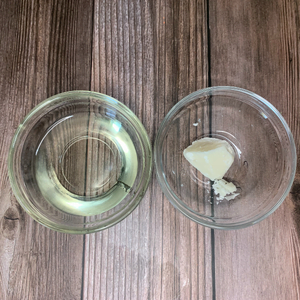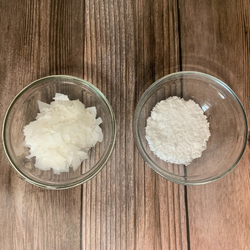This is an introduction of the ingredients, basic process and concepts of making lotion from scratch. Making lotion is actually really easy with 4 simple ingredients: water, oil, emulsifier and preservative. Before you make a lotion, you will want to understand what these ingredients are and why we use them.
Table of Contents
Prefer to watch this project instead of reading it?
Some of the links are affiliate links, because I am an associate and I earn a small commission on them.
Lotion is made by combining oils and water with an emulsifier. The final texture of your lotion will depend on the ingredients you have chosen.
Components that make up a lotion
Water
Body lotions are mostly made up of water, typically between 70-80% of the recipe. You’ll want to use distilled water. The more water you use the thinner the lotion will be.
Water can always be substituted with a hydrosol. A hydrosol is the left over water from steam distillation of plants and herbs.
Oils / Butters

The oils that you choose will have an effect on the feel of your lotion. The more oil that is used, the thicker and heavier the finished lotion will be. The type of oil you use will also make a difference, using cocoa butter would give you a different texture than using sunflower oil. We typically use oils at 10-20% of the lotion.
Typically you are going to use the lighter oils in a face lotion and the heavier oils in a body lotion.
- Lighter Oils
- Fractionated coconut oil
- Sunflower oil
- Safflower oil
- Medium Oils
- Rice bran oil
- Sweet almond oil
- Jojoba Oil
- Heavier Oils
- Olive oil
- Avocado oil
Butters add a protective barrier to our skin and the add a thickness to the lotion. The hard / brittle butters will thicken the lotion and the soft butters will make it thinner.
- Brittle Butters
- Cocoa butter
- Kokum butter
- Soft Butters
- Shea butter
- Mango butter
Emulsifier
Since oil and water do not mix, we need to use an emulsifier. There are many different emulsifiers, each with their own strengths. The last thing that you want is to have your water and oil to separate on you. You can learn more about emulsions here.

In this lotion, am using Olivum 1000 for the emulsifier. It is an oil-in-water emulsifier and the suggested use rate is 2-8%. The maximum oil phase you should have with this emulsifier is 25% or less (including the Olivum 1000).
In addition to emulsifiers, there are co-emulsifiers that we use. Now these co-emulsifiers cant make the emulsion on their own, but they help to make the emulsion stronger so that the oils and water doesn’t separate. These are typically 6-8% of a recipe.
For my co-emulsifier, I am using cetyl alcohol. The word alcohol is kind of misleading because you often associate that with drying your skin, but in fact it is moisturizing for our skin.
Preservative
Anytime you are adding water in a recipe, you have to use a broad spectrum preservative otherwise you will grow mold and bacteria in your lotion. Depending on the preservative you will use between .5-1% in a lotion. I am using Germall Plus and using .5% for this lotion.
If you prefer not to use a preservative, I would recommend making an oil based butter (like this one). Since the body butter does not container water, it does not require a preservative.
Optional Ingredients
You can always add specialty ingredients to your lotion. It can be anything from extracts, scents, colors and humectants. Fragrance oil or essential oil can be added, typically at about 1% but you will want to check the use rate of your fragrance to be sure. I am using White Tea and Pear Fragrance Oil.
I like to add a bit of color to my lotion using skin safe mica powder.
Creating your lotion
So how do we turn these ingredients into a lotion?
Once you know the basic percentages for each ingredient group, you can put together your own formula. You want to fill in the percentages for all ingredients and use to water to get you to 100%.
Basic Lotion Formula
74.5% Distilled Water
13% Liquid Oil
3% Kokum Butter
5% Olivum 1000 (Emulsifier)
3% Cetyl Alcohol (Co-Emulsifier)
1% White Tea & Pear Fragrance Oil
0.5% Liquid Germall Plus (Preservative)
You might be wondering why this is in percentage form and not be weight. That is because it is a formula not a recipe. When you make a formula, it is really easy to size it to any size batch. You can use this to make 8 ounces of lotion or 50 ounces.
If you are not familiar with converting a formula to a recipe, check out this video where I go over how to create one.
Making lotion from scratch
Ok, so now that we have a recipe, how do we make it?
Clean The Work Area
You want to always start out by disinfecting your work area and equipment that you will be using.
Weigh Ingredients
I see a lot of formulas that use cups for measurements. Which is great when you are cooking food and the measurements do not have to be precise, but it doesn’t work when you are making your own lotions. You need to be using a scale to get an accurate weight. I would recommend one the goes to 0.01 ounce.
I like to weigh each ingredient into a separate container and then mix the phases together. If you prefer, you can put all of one phase ingredient (oil phase) into one container. Just be sure to press the ‘tare’ button in between each ingredient.
Heat Ingredients
In a double boiler, heat both the water phase and the oil phase. You are going to heat them both until the oil phase has melted fully.
Combining Phases
Once you have removed both phases from the double boiler, you are going to combine them together immediately. In order to get a stable emulsion, you will want to mix them with an immersion blender.
While the ingredients are still warm they may want to separate (which is completely normal). To prevent this just mix periodically with the immersion blender.
Cool Down
Once your lotion has cooled down to 90° F, you can add your heat sensitive ingredients. After you add them, mix well with the immersion blender.
Packaging
Pour your lotion into your container. If it is too thick to pour, you can always put it in to a baggie and cut one of the corners to make it easier and less messy. You are going to want to wait until it is cooled down to room temperature before you put the cap on it. If you put the cap on while it is still warm it could cause condensation that would pool on the top of the lotion and grow mold.
Making Lotion From Scratch
Equipment
- Scale
Ingredients
- 6.71 ounce | 74.5% Distilled Water
- 1.17 ounce | 13% Sunflower Oil
- 0.27 ounce | 3% Kokum Butter
- 0.45 ounce | 5% Olivum 1000
- 0.27 ounce | 3% Cetyl Alcohol
- 0.09 ounce | 1% White Tea and Pear Fragrance Oil
- 0.05% | 0.5% Germall Plus
Instructions
Clean
- You want to always start out by disinfecting your work area and equipment that you will be using.
Weigh Ingredients
- I see a lot of formulas that use cups for measurements. Which is great when you are cooking food and the measurements do not have to be precise, but it doesn't work when you are making your own lotions. You need to be using a scale to get an accurate weight. I would recommend one the goes to 0.01 ounce.I like to weigh each ingredient into a separate container and then mix the phases together. If you prefer, you can put all of one phase ingredient (oil phase) into one container. Just be sure to press the 'tare' button in between each ingredient.
Heat Ingredients
- In a double boiler, heat both the water phase and the oil phase. You are going to heat them both until the oil phase has melted fully.
Combining Phases
- Once you have removed both phases from the double boiler, you are going to combine them together immediately. In order to get a stable emulsion, you will want to mix them with an immersion blender. While the ingredients are still warm they may want to separate (which is completely normal). To prevent this just mix periodically with the immersion blender.
Cool Down
- Once your lotion has cooled down to 90° F, you can add your heat sensitive ingredients. After you add them, mix well with the immersion blender.
Packaging
- Pour your lotion into your container. If it is too thick to pour, you can always put it in to a baggie and cut one of the corners to make it easier and less messy. You are going to want to wait until it is cooled down to room temperature before you put the cap on it. If you put the cap on while it is still warm it could cause condensation that would pool on the top of the lotion and grow mold.

